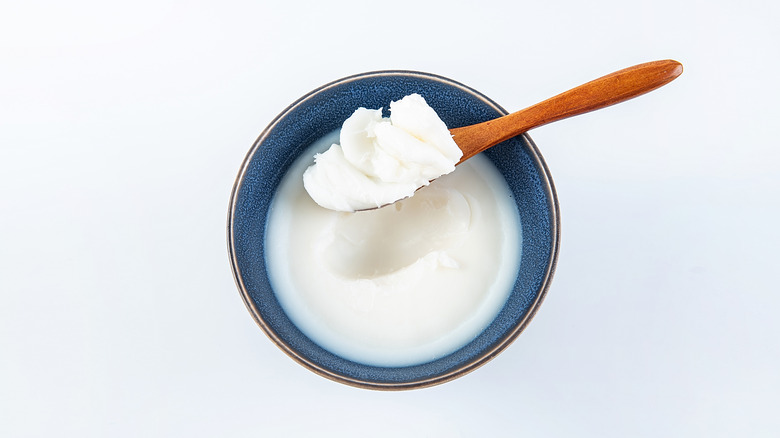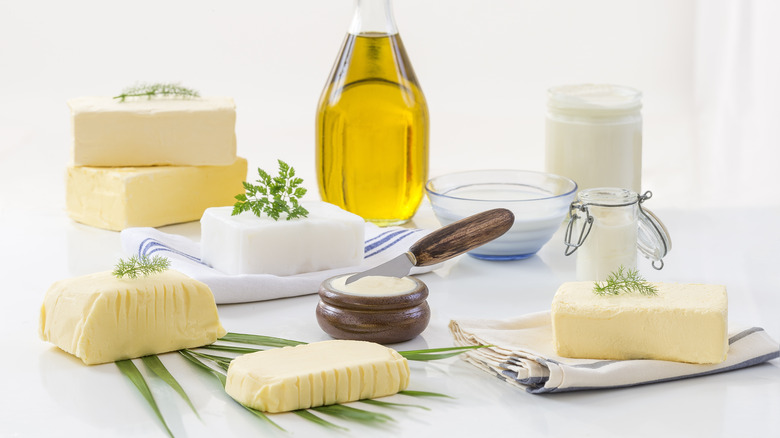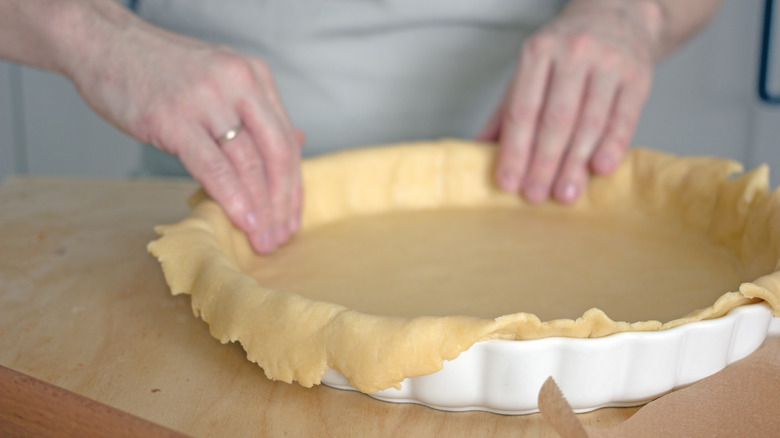What Is Lard Made Of? (And When To Use It)
These days, the word "lard" seems more likely to work its way into a conversation than into our pantries. You don't see many modern cookbooks calling for lard, and it's become so uncommon that you might not even know what it is. Lard is solid fat rendered from pigs – it may not be the most appealing description, but it's the truth. Lard can be rendered either by steaming the pork fat or cooking it down in a kettle, with the main difference being that kettle-rendered lard tends to be somewhat darker in color. Lard has a similar consistency as butter, and often comes in bricks as well, but they don't taste remotely alike. In fact, lard often has no flavor at all, and when it does, it's only a slight hint of porkiness on the palate.
Lard used to be a staple of American kitchens, and many classic 20th-century cookbooks call for it liberally, typically for the purposes of frying or pastry-making. That changed in the 1980s when Americans adopted the ideology of low-fat eating. Fat, it was widely believed, was the main culprit in heart disease, obesity, and many other health concerns. In retrospect, the reasoning was far too simple, as people failed to differentiate between unsaturated, saturated, and trans fat and completely ignored the effects of carbohydrates and sugar. Today, we've achieved a better understanding of nutrition, but lard doesn't seem likely to make a comeback. Nevertheless, there are some recipes that still benefit from lard.
Lard vs other fats
Lard is one of the multiple animal fats used in cooking, with other key examples being beef fat, known as "tallow" or "suet," and chicken fat, known as "schmaltz." However, these days, animal fats have largely been replaced by plant-based oils and vegetable shortening. Vegetable, canola, and olive oils contain mostly unsaturated fats, sometimes known as "good fats," which may lower your risk of certain diseases, according to the Harvard T.H. Chan School of Public Health. Lard contains more saturated fat, which can increase your risk of heart disease. It may have been unreasonable for people in the 80s and 90s to shun all kinds of fat, but saturated fat actually is the kind of thing you need to limit. Hence, lard is something to use in moderation.
A key difference between lard and most plant-based oils is their consistency. Lard is a solid, but oil is a liquid, making it a poor substitute for lard in some scenarios. When people need a solid alternative, they often turn to vegetable shortening, which many people refer to by the name of its most iconic brand: Crisco. Shortening is by infusing vegetable oil with hydrogen in a process called hydrogenation. We now know that hydrogenation creates trans fats, which pose an even greater threat to our health than saturated fats. Trans fats have been phased out of many foods, and this is one scenario where lard would actually be the healthier choice (if only by a small margin).
What to cook with lard
Lard used to be the standard for frying foods, and you can certainly use it for that purpose if you wish. However, frying first entails melting the lard into a liquid, at which point you might prefer to sub it out for vegetable oil to reduce your saturated fat intake. There is one major advantage to frying in lard that you probably wouldn't expect, though. Lard actually makes fried food less greasy than oil-frying does, which would be an advantage for foods like fish and chips or doughnuts, which need to have crispy exteriors while remaining light and delicate on the inside. However, lard is going to be most useful in circumstances when a solid fat is absolutely necessary, and these will typically be baked goods.
Lard is the classic choice for making biscuits and pie crusts, and while you could use butter or shortening instead, many bakers swear that lard makes the flakiest dough of all. Lard is also easier for bakers to work with because of its higher melting point. Butter has such a low melting point that it can soften from the heat of your hands alone. This is a frustrating obstacle when you are hand-kneading dough. Obviously, lard isn't for everyone. Health concerns aside, those who stick to vegetarian, kosher, or halal diets can't use it. Fortunately for them, there are many substitutes available. Still, if you want an old-school pie like Grandma made, you just can't beat lard.


